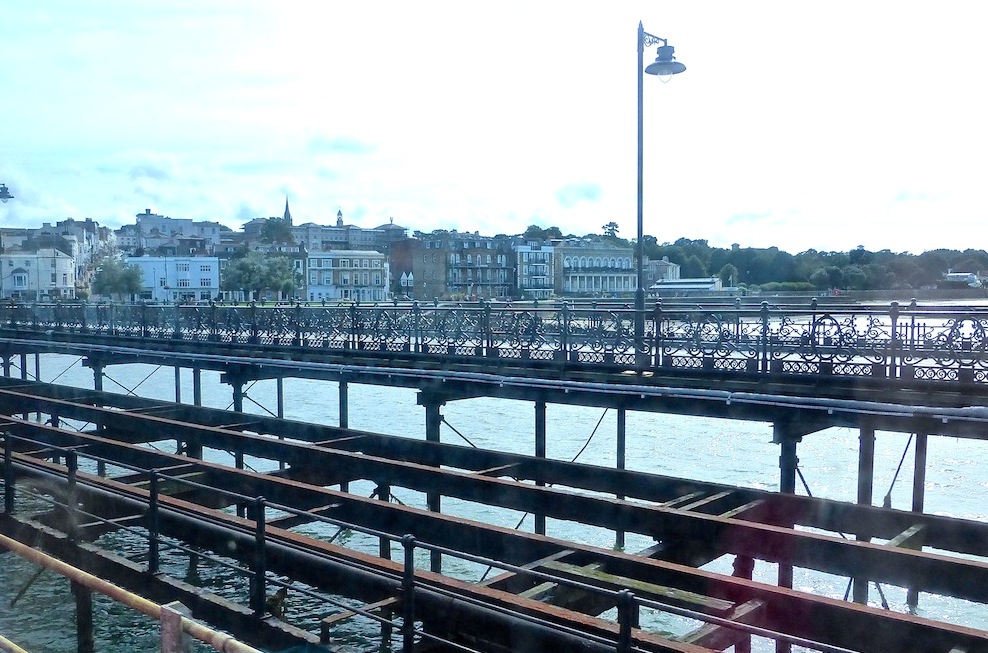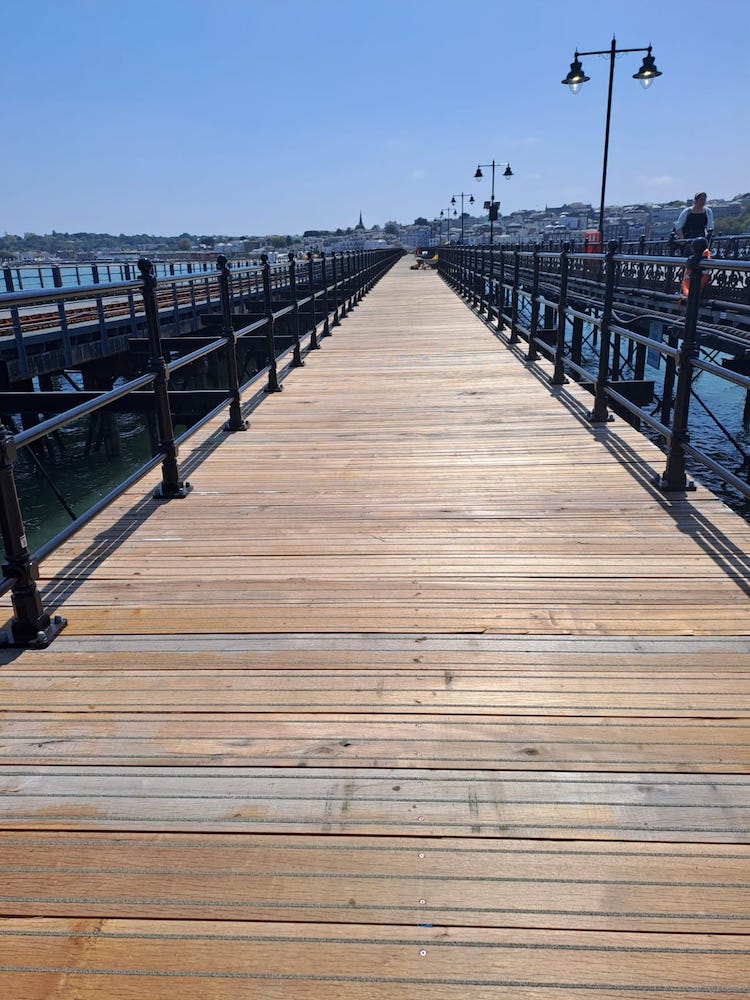

Ryde Pier-head: Left: view from the pedestrian part of the pier. © David Dixon, originally posted on the Geograph website, and available for reuse, with attribution, on the Creative Commons Licence. Right: Inside the pier-head building (author's photograph).
Ryde Pier, Isle of Wight. As well as providing a promenade from the seaside at Ryde, this Grade II listed pier provides a railway link between the shore and the pier-head terminal of the Isle of Wight/Portsmouth ferry. The first "promenade" pier was completed as early as 1814, making it the oldest one in the country. It was then extended ten years later, and reached its full length (nearly half a mile) in 1842, making it the second longest in the country (see "Ryde Pier"). Then a separate, parallel pier was constructed in 1864, for horse-drawn trams, which remained even after electrification, right up until 1969. Some of this first parallel structure can still be seen. But its function was replaced by another parallel pier, this time for trains, in 1880 (see Lloyd and Pevsner 238). This one is still used by the island's antiquated trains, retired tube-trains acquired from London in 1988 but actually dating from the 1930s. In 1895 the mixed-purpose pier with its promenade and train tracks acquired one of the conventional attributes of a seaside pier: a concert pavilion at the pier-head, which later became a ballroom.

View of the parallel tracks of Ryde pier taken from the train bringing passengers from the Isle of Wight ferry terminal at the pier-head to Ryde and beyond. Notice the pedestrians on the promenade side of the pier. (Author's photograph.)
As far as heritage goes, Ryde pier is interesting mainly for its variety of tracks, and their histories. In later years, the wooden piles were replaced by iron ones, and the whole train pier was rebuilt in concrete in the 1930s. Even the old Victorian pier-head waiting rooms went in the early 1930s (for more details, see the National Piers Society entry listed below). An old lifeboat station was also demolished. "Architecturally, there is hardly anything to note, apart from the repetitive heavy ironwork on the balustrades" (Lloyd and Pevsner 238). This rather elaborate ironwork, however, does have a certain appeal.


Left: View of the pier, showing remains of the earlier tram part between the railway tracks and the promenade. Right: View of the town (Ryde) from across the water. (Author's photographs).
As David Lloyd and Nikolaus Pevsner point out in an unusually lyrical description, the most picturesque thing about the pier now is the view of the old Regency/Victorian town at the shore end (238-39). "Buildings climb the slope, and the skyline, still Victorian, is punctuated by church spires and the Town Hall turret. Towards the W. and more distantly the E., the buildings are interspersed with greenery" (239). In the photograph above right, the building with the tower and cupola is Ryde Town Hall of 1829-31, and the landmark church with the tall spire is Holy Trinity, Ryde, 1868-72 by George Gilbert Scott, rather a family affair as its spire was added by his son, John Oldrid Scott, in 1881-82.
Update on Ryde Pier (Spring 2024)


Left: Looking down on the pier: work in progress. Right: New sections of metal added below, to raise the height. (Photographs, credit: Knights Brown.)
Michael Riley writes to inform us that the old tramway part of Ryde Pier has recently been totally renovated/rebuilt to provide a pedestrian walkway between Ryde Esplanade and the pierhead.


Left: The last plank in place. Right: Ready for pedestrian use. (Photographs, credit: Knights Brown.)
Riley explains, "The lower parts of the original metal piles were kept, and new sections of metal added to raise the height, and then hardwood beams, metal railings, and traditional-style shelters installed along the length." As seen, the result is stunning!
You may use the author's photographs without prior permission for any scholarly or educational purpose as long as you (1) credit the photographer and (2) link your document to this URL or cite it in a print document. [Click on all the images to enlarge them.]
Related Material
Bibliography
Lloyd, David W., and Nikolaus Pevsner. The Buildings of England: Isle of Wight. New Haven and London: Yale University Press, 2006.
"Ryde." National Piers Society. Web. 1 November 2017.
"Ryde Pier." Isle of Wight: The Island's Offcial Tourism Website. Web. 1 November 2017.
Created 1 November 2017